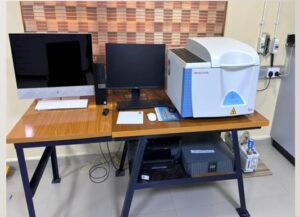NBRRI EDXRF Spectrometer: Advanced Elemental Analysis for Construction Materials
 NBRRI EDXRF Spectrometer
NBRRI EDXRF Spectrometer (Energy Dispersive X-Ray Fluorescence Spectrometer) is an advanced analytical instrument used by the Nigerian Building and Road Research Institute (NBRRI) to analyze the elemental composition of materials. It is particularly useful in construction and environmental applications, providing detailed insights into the chemical makeup of substances like cement, soil, asphalt, and other building materials.
Function
The primary function of the NBRRI EDXRF Spectrometer is:
- To identify and quantify the elemental composition of various materials by using X-ray fluorescence technology.
The device uses high-energy X-rays to excite atoms in a sample, causing them to emit characteristic “fluorescent” X-rays. By detecting these fluorescent X-rays, the spectrometer can determine which elements are present in the sample and their concentrations. This non-destructive analysis is essential for ensuring material quality, regulatory compliance, and safety in building and infrastructure projects.
Applications
The NBRRI EDXRF Spectrometer has a wide range of applications in fields requiring precise elemental analysis:
- Construction Material Analysis:
The spectrometer is widely used to evaluate construction materials like cement, sand, gravel, and concrete. By providing accurate data on the chemical composition, it helps ensure that materials meet industry standards and quality benchmarks.
- Soil Testing and Geotechnical Studies:
Soil samples can be analyzed for elements like calcium, potassium, magnesium, and iron. This information is essential for geotechnical studies, enabling researchers to understand soil composition and suitability for various construction projects.
- Environmental Monitoring and Hazard Detection:
The device is useful in environmental studies, such as detecting hazardous elements in construction materials or monitoring pollutants in soil and sediments. It helps identify toxic elements like lead, arsenic, or mercury, ensuring safety and regulatory compliance.
- Asphalt and Road Material Testing:
In road construction, the spectrometer can be used to analyze bitumen and other road materials for elements that influence durability, stability, and resistance to weathering.
How It Works
The NBRRI EDXRF Spectrometer works by emitting high-energy X-rays onto a sample and analyzing the resulting fluorescent X-rays:
- Sample Preparation:
The sample (solid, powder, or liquid) is placed in the spectrometer’s sample chamber.
- X-Ray Excitation:
The spectrometer emits high-energy X-rays, which strike atoms in the sample. This excitation causes the atoms to emit secondary “fluorescent” X-rays unique to each element.
- Detection and Analysis:
The fluorescent X-rays are detected by the spectrometer’s sensors, which interpret the wavelengths and intensities to identify elements and determine their concentrations.
- Results Interpretation:
The spectrometer software displays the results, showing a detailed breakdown of elemental composition, usually in percentages or parts per million (ppm).
This non-destructive testing method provides fast, reliable results, making it ideal for laboratory and field applications.
Benefits of the NBRRI EDXRF Spectrometer
- Ensures Material Quality and Safety: Precise elemental analysis helps verify that materials meet safety and quality standards, essential for reliable construction practices.
- Facilitates Environmental Protection: By detecting hazardous elements, the spectrometer aids in environmental monitoring and compliance with health regulations.
- Supports Research and Innovation: The NBRRI EDXRF Spectrometer is instrumental in research for developing new materials and improving existing ones, enhancing sustainability and performance in construction.
NBRRI EDXRF Spectrometer is a valuable tool for the Nigerian Building and Road Research Institute, providing essential data on the elemental composition of materials. It supports quality assurance, environmental monitoring, and scientific research, contributing to safer and more sustainable infrastructure in Nigeria.
 NBRRI EDXRF Spectrometer (Energy Dispersive X-Ray Fluorescence Spectrometer) is an advanced analytical instrument used by the Nigerian Building and Road Research Institute (NBRRI) to analyze the elemental composition of materials. It is particularly useful in construction and environmental applications, providing detailed insights into the chemical makeup of substances like cement, soil, asphalt, and other building materials.
NBRRI EDXRF Spectrometer (Energy Dispersive X-Ray Fluorescence Spectrometer) is an advanced analytical instrument used by the Nigerian Building and Road Research Institute (NBRRI) to analyze the elemental composition of materials. It is particularly useful in construction and environmental applications, providing detailed insights into the chemical makeup of substances like cement, soil, asphalt, and other building materials.
